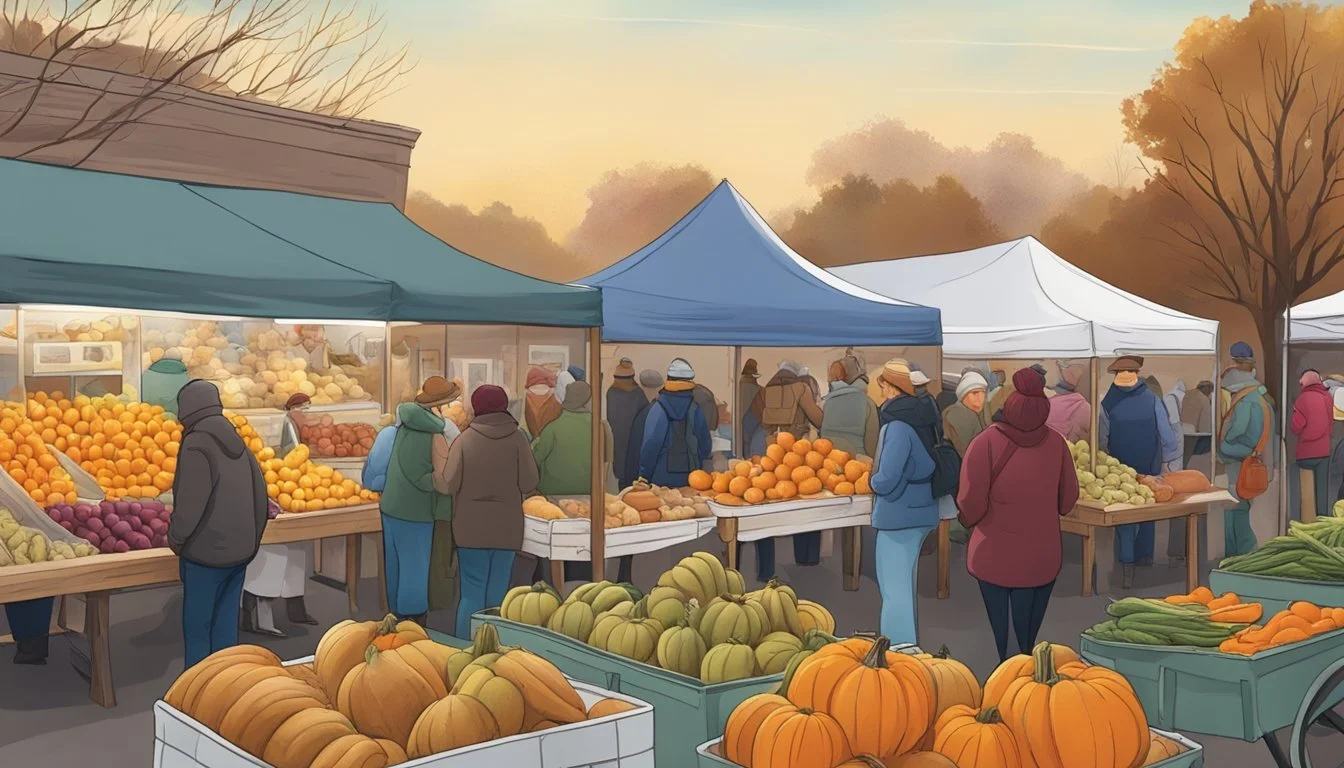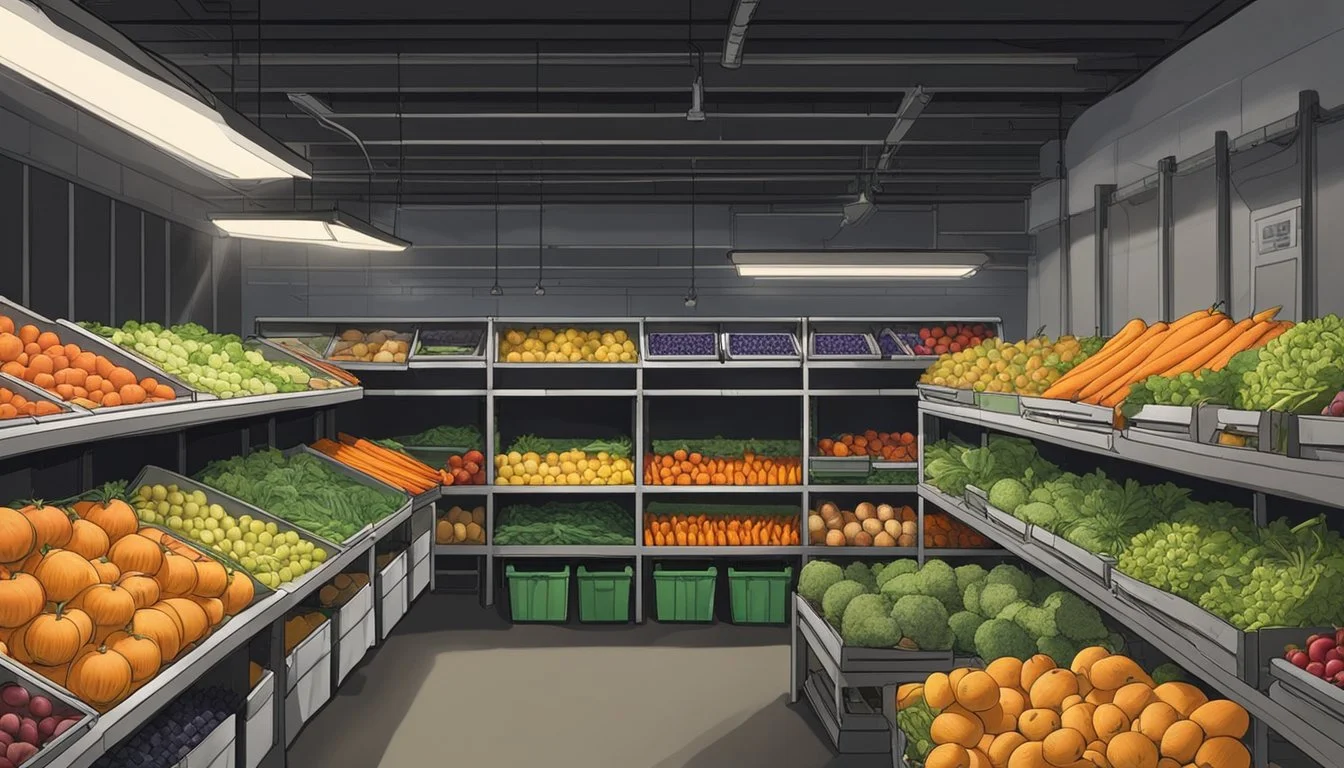Maine Seasonal Fruit & Vegetables in February
Your Guide to Winter Produce
This Article is Part of our Maine Seasonal Fruit & Veg Calendar
February in Maine is a time of both challenge and creativity for those who enjoy fresh, local produce. As winter grips the region, the variety of fruits and vegetables available is naturally more limited compared to the abundance of the warmer months. Yet, Maine's committed farmers and producers continue to supply a select array of hardy produce to consumers.
Seasonal vegetables such as beets, cabbage, carrots (how long do carrots last?), and leeks remain available thanks to Maine's innovative agricultural practices which include, among others, the use of cold storage and greenhouse farming. Celeriac and potatoes also persist through the winter, a testament to their storability and the forethought of farmers planning for the cold season.
Fruits are less abundant during this time, but apples, preserved from the fall harvest, can still be found crisp and flavorful. While fresh berries and summer fruits won't return until warmer days, the local markets keep the community connected to the fruits of prior seasons' labors. Maple syrup (how long does maple syrup last?) production, a sign of the coming spring, often begins in February, offering a sweetener produced from one of Maine's most iconic trees.
Understanding Maine's Winter Season
In Maine, winter brings unique considerations for agriculture, with the climate directly affecting the harvest. Despite the challenges, certain crops thrive during this season.
Climate Impact on Produce
Maine experiences cold winters that typically include heavy snowfall and freezing temperatures. These conditions make it challenging to grow a wide array of produce. However, the use of greenhouses and other protective measures allow for the cultivation of some hardy varieties.
Winter Harvest Varieties
The crops available during winter in Maine are those that can withstand the harsh climate. Root vegetables such as carrots and potatoes are common. Additionally, apples stored from the fall harvest continue to be available. Greens like kale and spinach may be harvested from climate-controlled environments.
February's Seasonal Challenges
February often presents the peak of winter's harshness. Farmers must protect their crops from frost and extreme cold, which can be damaging to produce and farm infrastructure. The limited daylight hours also restrict the growing potential for many crops during this month.
Seasonal Vegetables in February
In February, despite the colder climate, Maine still offers a selection of fresh produce. The vegetables available are typically hearty and robust, capable of withstanding the chill of winter.
Greens and Cruciferous Vegetables
Maine's winter gardens yield a variety of greens and cruciferous vegetables. Kale and cabbage stand out as staples during this month. They are versatile in the kitchen and can be incorporated into a range of dishes, from stews and soups to fresh salads with a hearty texture.
Kale: Rich in nutrients, this green can be found fresh and is ideal for sautéing or adding to smoothies.
Cabbage: Another robust vegetable, cabbage is commonly used for slaws or fermented to make sauerkraut (how long does sauerkraut last?), providing both flavor and nutrition.
Root Vegetables and Tubers
Root vegetables are at their best in February, as they can be stored well through the winter months and still maintain their flavor and nutritional value.
Potatoes: A versatile tuber that forms the base for many comfort foods like mashed potatoes and hearty soups.
Carrots: Known for their sweetness and crunch, carrots are an excellent addition to both cooked and raw dishes.
Onions: Essential for adding depth of flavor to countless recipes, onions are a kitchen staple available throughout the winter.
Vegetable Uses in Cuisine Potatoes Soups, mashes, and roasts Carrots Salads, soups, and side dishes Onions Aromatic base for sauces, soups, and stews
Consumers can still enjoy these vegetables in February, ensuring meals are nutritious and seasonally appropriate.
Seasonal Fruits Available
In February, residents of Maine continue to enjoy fruits, particularly storage-friendly varieties such as apples, which keep well through the winter months. While the choice of fresh, locally-grown fruits is more limited during this time, consumers are still able to access a selection of produce that includes cold-hardy options and imported fruits.
Winter Storage Fruits
Maine's cool climate contributes to the longevity of certain fruits that are harvested in the fall and stored through the winter. The primary fruits available from local storage in February are:
Apples: Various types including heirloom and newer varieties retain their firmness and flavor during storage.
Pears: They have a shorter storage life but can still be found in good condition if properly kept.
Imported Fruits Awareness
While local offerings are limited during the winter months, imported fruits provide diversity to the market. However, consumers should remain aware of the greater environmental impact due to transportation and the potential differences in taste and freshness compared to locally grown produce. Common imported fruits found in Maine during February include:
Bananas
Citrus fruits (like oranges and grapefruits)
Grapes
Fruit lovers are encouraged to inquire about the origin of their fruits to make informed choices regarding quality and sustainability.
Farmers’ Market Guide for February
February in Maine brings a unique variety of produce that can be found at local farmers' markets. Shoppers will find winter staples grown by dedicated farmers who employ methods to extend the availability of fresh produce.
What to Look For
Produce Availability:
Apples: Look for varieties that are good this time of year, typically stored from the fall harvest.
Root Vegetables: Such as beets, carrots, and celeriac which are winter hearty.
Alliums: Like leeks and garlic, offering aromatic additions to winter dishes.
Greens: Including cabbage, which remains crisp during cooler temperatures.
Maple Syrup: Freshly harvested as the sugaring season begins.
Planning Your Visit
Hours and Location: Check the specific hours and locations of farmers' markets, as they can vary in the winter season.
Weather: Be prepared for winter weather conditions; wear appropriate attire and check for any market closures before visiting.
Payment: Many farmers accept cash, and some may offer card or mobile payment options; check ahead for specifics.
Ask Producers: Engage with farmers about their produce and recommended recipes; they can provide valuable insights about the quality and uses of their crops.
By focusing on seasonal staples and engaging with local farmers, visitors can enrich their culinary experience even in the midst of winter.
Storage and Preservation Tips
When preserving Maine's seasonal fruits and vegetables in February, understanding proper storage and preservation methods ensures maximum freshness and longevity. These techniques can maintain the taste and nutritional value of produce during the winter months.
Extending Freshness
For fruits like apples and winter pears, which are still in season, proper cold storage is key. They should be kept in a cool, dark place with good air circulation. Vegetables such as carrots and potatoes also last longer when stored in a cool, humid environment away from light, which prevents sprouting and spoilage.
Refrigerator Storage:
Apples: In the crisper drawer at 34-38°F, in perforated plastic bags to retain humidity.
Root Vegetables: In a slightly dampened, loosely-closed bag to maintain humidity.
Counter Storage:
Winter Squash: In a cool, dry place, away from direct sunlight.
Onions and Garlic: In a dark, well-ventilated area to discourage mold and sprouting.
Canning and Freezing
Canning and freezing are effective ways to preserve the bounty of Maine's seasonal produce.
Canning: Suitable for making jams and pickles, canning captures the essence of fresh fruits and veggies. Strawberries, although not in season in February, can be used from frozen stocks to make jam. Vegetables like beets are ideal for pickling at this time of year.
Jams: Use a water bath method for high-acid fruits.
Pickles: Vinegar and salt solutions are crucial for the pickling process.
Freezing: Freezing is another excellent option for long-term preservation. Blanching vegetables before freezing helps to maintain their quality.
Blanching Steps:
Boil vegetables briefly.
Plunge them into ice water.
Dry thoroughly and freeze in airtight containers.
Freezing Fruit: Berries and sliced fruits can be frozen on a tray before being transferred to airtight containers to prevent clumping.
Recipes incorporating preserved foods can be enjoyed throughout the year, maintaining a connection to the local harvest during off-season months.
Cooking with Seasonal Produce
In February, Maine's local produce offers a treasure trove of flavors and nutrients ideal for hearty winter meals and creative uses of greens and root vegetables. With a focus on utilizing what's in peak season, one can elevate their cooking with fresh, local ingredients.
Hearty Winter Recipes
Seasonal fruits like apples provide the perfect balance of sweetness in recipes such as apple preserves or tangy apple salsa. The array of available squash varieties, including butternut and acorn, make for excellent soups and stews. Here's a simple table pairing produce with potential dishes:
Seasonal Ingredient Suggested Recipe Apples Apple Salsa Squash Butternut Squash (how long does butternut squash last?) Soup Parsnips Roasted Parsnip Puree
One might use squash in recipes like roasted squash halves filled with a mix of grains and nuts or parsnips caramelized to perfection, enhancing their natural sweetness and pairing well with savory herbs in a comforting winter meal.
Using Greens and Root Vegetables
Root vegetables such as carrots and parsnips are not only versatile but also nutritious, and play a prominent role in February meals. They can be roasted to bring out their sweetness or used in aromatic stocks and broths. Greens like kale and Swiss chard can be quickly sautéed with garlic and olive oil, adding a vibrant touch to any plate.
A chef can create dynamic dishes such as a roasted root vegetable medley or a bright, peppery greens salad. Employing these ingredients in dishes not only supports local agriculture but also ensures peak flavor and nutrition. For example:
Roasted Parsnips: Toss with olive oil, salt, and rosemary, roast until tender.
Squash: Cube and add to a warming curry or blend into a creamy soup.
Greens: Incorporate into salads, or wilt into pasta (how long does pasta last?) and grain dishes.
Cooking with what is seasonally available encourages the exploration of new flavors and techniques while remaining true to the local culinary landscape.
Health Benefits of Seasonal Eating
In Maine, as in much of the world, eating with the seasons comes with numerous health benefits. Seasonal eating involves consuming fruits and vegetables close to the time of their natural harvest period, ensuring peak freshness, flavor, and nutritional value.
Nutritionists assert that fruits and vegetables are richest in vitamins and minerals when they're ripe and freshly harvested. For instance, vitamins such as C and A can diminish over time, so the shorter the time from farm to table, the better.
Variety: A seasonal diet introduces a diverse range of nutrients. Winter selections, such as root vegetables, carry essential vitamins and minerals that support immune function during colder months.
Freshness: Seasonal produce is typically fresher, having been harvested at the optimum time, and therefore often tastes better and may be more nutritious.
Environmental Benefits: Locally sourced, in-season produce can reduce the carbon footprint associated with long-distance transportation. Eating seasonally supports the environment by lowering the demand for out-of-season produce and the extensive energy required to grow and transport it from different climates.
Maine's February offerings might include storage crops like apples and root vegetables that are still nutritious and hearty options for winter meals. Incorporating these into the diet can contribute to better health outcomes, such as a reduced risk of chronic diseases.
Eating with the seasons also supports the local economy. When consumers choose seasonal foods, they're often purchasing directly from nearby farmers, fostering community and economic stability within the region.
Overall, when Maine residents opt for seasonal eating, they are making choices that are beneficial for their health, their community, and the environment.
Supporting Local Agriculture
In the midst of winter, options for local produce in Maine may be limited, but supporting local agriculture remains crucial. Two key strategies for supporting this sector involve participating in Community Supported Agriculture programs and recognizing the benefits of buying local, both of which contribute to a sustainable local economy and a robust community.
Community Supported Agriculture (CSA)
Community Supported Agriculture (CSA) programs in Maine foster a direct partnership between consumers and farms. Customers subscribe to the harvest of a particular farm or group of farms, typically paying up-front. This model provides financial security for farmers at the beginning of the growing season and gives consumers a share of fresh, local produce throughout the season.
How it works:
Farmers offer subscriptions or "shares" of their harvest.
Members prepay for their share, providing crucial early-season capital for farmers.
Through the season, members receive regular distributions of fresh produce, often weekly.
Through CSAs, consumers in Maine have a unique opportunity to directly support their local farmers and the agricultural community, while enjoying seasonal bounty even in the leaner months through preserved goods or winter-hardy crops.
Benefits of Buying Local
Purchasing local produce provides significant benefits to both the Maine economy and the community at large. When consumers buy from local farms, they keep money circulating within the local economy, which supports job creation and retains wealth in the area.
Economic Impact:
Jobs: Local farms employ area residents, supporting community livelihood.
Wealth Retention: Money spent locally is more likely to be reinvested in the local economy.
Environmental and Health Advantages:
Freshness: Local products are fresher and often more nutritious.
Reduced Footprint: Short transportation distances mean less environmental impact.
Consumers also enjoy more transparency regarding where their food comes from and how it's grown, fostering trust and community between farmers and their patrons. By choosing to support local farms, Maine residents ensure a vibrant, sustainable agricultural sector for generations to come.
Factoring in Food Miles
When consumers in Maine consider purchasing seasonal fruits and vegetables in February, it's essential to factor in food miles—the distance food travels from production to consumer. Food miles directly relate to a product's environmental impact, predominantly due to transportation emissions.
Local sourcing of produce such as winter squash, potatoes, and stored apples reduces food miles. These items often travel a short distance to reach Maine markets, as they are stored from previous growing seasons or cultivated in local greenhouses.
Transportation of out-of-season or non-native produce consumes more energy, generating more greenhouse gases. For example, importing berries or summer fruits in February can substantially increase food miles.
Here’s a quick comparison:
Local Produce:
Winter Squash
Potatoes
Apples
Environmental Impact: Low Food Miles - Shorter transportation means less fuel used and lower emissions.
Imported Produce:
Berries
Summer Fruits
Environmental Impact: High Food Miles - Longer distances increase fuel consumption and greenhouse gas emissions.
The choice to buy local isn't just about freshness; it's a positive step for the environment. Shoppers can minimize their carbon footprint by choosing seasonal, locally available produce. By doing so, they support the regional economy while also advocating for a healthier planet through conscious consumerism. Consider proximity and seasonality to make informed, eco-friendly choices.









